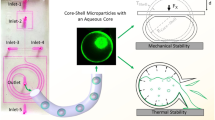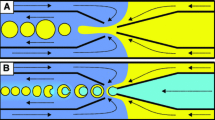Abstract
Accurate control of monodisperse core–shell droplets generated in a microfluidic device has a broad range of applications in research and industry. This paper reports the experimental investigation of flow-focusing microfluidic devices capable of producing size-tuneable and monodisperse core–shell droplets. The dimension of the core–shell droplets was controlled passively by the channel geometry and the flow rate of the liquid phases. The results indicate that microchannel geometry is more significant than flow rates. The highly controllable core–shell droplets could be subsequently employed as a template for generating core–shell microparticles with liquid core. Optical, electron scanning microscopy and X-ray computed microtomography showed that the geometry of the core–shell droplets remains unchanged after solidification, drying and collection. The present study also looks at the thermal stability of core–shell particles depending on the particle size. The larger core–shell particles with a thicker shell provide a higher resistance to heating at elevated temperature. The high degree of control with a flow-focusing microfluidic device makes this a promising approach for the encapsulation, storage, and delivery of lipophilic contents.








Similar content being viewed by others
Availability of data and material
Not applicable.
Code availability
Not applicable.
References
Bandara T, Nguyen NT, Rosengarten G (2015) Slug flow heat transfer without phase change in microchannels: a review. Chem Eng Sci. https://doi.org/10.1016/j.ces.2014.12.007
Carneiro J, Doutel E, Campos JBLMJBLM, Miranda JM (2016) PDMS droplet formation and characterization by hydrodynamic flow focusing technique in a PDMS square microchannel. J Micromech Microeng 10:105013. https://doi.org/10.1088/0960-1317/26/10/105013
Chong DT, Liu XS, Ma HJ, Huang GY, Han YL, Cui XY, Yan JJ, Xu F (2015) Advances in fabricating double-emulsion droplets and their biomedical applications. Microfluid Nanofluid 5:1071–1090. https://doi.org/10.1007/s10404-015-1635-8
Costa ALR, Gomes A, Cunha RL (2017) Studies of droplets formation regime and actual flow rate of liquid-liquid flows in flow-focusing microfluidic devices. Exp Thermal Fluid Sci. https://doi.org/10.1016/j.expthermflusci.2017.03.003
Galogahi FM, Zhu Y, An HJ, Nguyen NT (2020) Core-shell microparticles: generation approaches and applications. J Sci Adv Mater Dev 4:417–435. https://doi.org/10.1016/j.jsamd.2020.09.001
Good RJ, Girifalco L (1960) A theory for estimation of surface and interfacial energies. III. Estimation of surface energies of solids from contact angle data. J Phys Chem 5:561–565. https://doi.org/10.1021/j100834a012
Gorgannezhad L, Sreejith KR, Christie M, Jin J, Ooi CH, Katouli M, Stratton H, Nguyen N-T (2020) Core-Shell Beads as Microreactors for Phylogrouping of E. coli Strains. Micromachines 8:761. https://doi.org/10.3390/mi11080761
Gregory S (2018) Physical properties of glycerine. CRC Press, Glycerine, pp 113–156
Hu SH, Liu DM, Tung WL, Liao CF, Chen SY (2008) Surfactant-free, self-assembled PVA-iron oxide/silica core-shell nanocarriers for highly sensitive, magnetically controlled drug release and ultrahigh cancer cell uptake efficiency. Adv Funct Mater 19:2946–2955. https://doi.org/10.1002/adfm.200800428
Lashkaripour A, Rodriguez C, Ortiz L, Densmore D (2019) Performance tuning of microfluidic flow-focusing droplet generators. Lab Chip 6:1041–1053. https://doi.org/10.1039/C8LC01253A
Lee W, Walker LM, Anna SL (2009) Role of geometry and fluid properties in droplet and thread formation processes in planar flow focusing. Phys Fluids 3:032103. https://doi.org/10.1063/1.3081407
Liao QQ, Zhao SK, Cai B, He RX, Rao L, Wu Y, Guo SS, Liu QY, Liu W, Zhao XZ (2018) Biocompatible fabrication of cell-laden calcium alginate microbeads using microfluidic double flow-focusing device. Sens Actuat A Phys. https://doi.org/10.1016/j.sna.2018.06.006
Lignel S, Salsac A-V, Drelich A, Leclerc E, Pezron I (2017) Water-in-oil droplet formation in a flow-focusing microsystem using pressure-and flow rate-driven pumps. Colloids Surf A. https://doi.org/10.1016/j.colsurfa.2017.07.065
Liu HH, Zhang YH (2009) Droplet formation in a T-shaped microfluidic junction. J Appl Phys 3:034906. https://doi.org/10.1063/1.3187831
Liu HH, Zhang YH (2011) Droplet formation in microfluidic cross-junctions. Phys Fluids 8:082101. https://doi.org/10.1063/1.3615643
Liu W, Yang XL, Ho WS (2011) Preparation of uniform-sized multiple emulsions and micro/nano particulates for drug delivery by membrane emulsification. J Pharm Sci 1:75–93. https://doi.org/10.1002/jps.22272
Lu YS, Xia Y, Larock RC (2011) Surfactant-free core-shell hybrid latexes from soybean oil-based waterborne polyurethanes and poly(styrene-butyl acrylate). Prog Org Coat 4:336–342. https://doi.org/10.1016/j.porgcoat.2011.03.027
Matsumoto K, Sogabe S, Endo T (2010) Synthesis and properties of methacrylate-based networked polymers having ionic liquid structures. J Polym Sci Part A Polym Chem 20:4515–4521. https://doi.org/10.1002/pola.24242
Mytnyk S, Ziemecka I, Olive AGL, van der Meer JWM, Totlani KA, Oldenhof S, Kreutzer MT, van Steijn V, van Esch JH (2017) Microcapsules with a permeable hydrogel shell and an aqueous core continuously produced in a 3D microdevice by all-aqueous microfluidics. RSC Adv 19:11331–11337. https://doi.org/10.1039/c7ra00452d
Nabavi SA, Vladisavljevic GT, Manovic V (2017) Mechanisms and control of single-step microfluidic generation of multi-core double emulsion droplets. Chem Eng J. https://doi.org/10.1016/j.cej.2017.04.008
Nguyen NT, Schubert S, Richter S, Dotzel W (1998) Hybrid-assembled micro dosing system using silicon-based micropump/valve and mass flow sensor. Sens Actu A Phys 1:85–91. https://doi.org/10.1016/S0924-4247(98)00039-9
Nie ZH, Seo MS, Xu SQ, Lewis PC, Mok M, Kumacheva E, Whitesides GM, Garstecki P, Stone HA (2008) Emulsification in a microfluidic flow-focusing device: effect of the viscosities of the liquids. Microfluid Nanofluid 5:585–594. https://doi.org/10.1007/s10404-008-0271-y
Nisisako T, Okushima S, Torii T (2005) Controlled formulation of monodisperse double emulsions in a multiple-phase microfluidic system. Soft Matter 1:23–27. https://doi.org/10.1039/b501972a
Rahimi M, Khorrami AS, Rezai P (2019) Effect of device geometry on droplet size in co-axial flow-focusing microfluidic droplet generation devices. Colloids Surf A. https://doi.org/10.1016/j.colsurfa.2019.03.067
Rausch MH, Kretschmer L, Will S, Leipertz A, Froba AP (2015) Density, surface tension, and kinematic viscosity of hydrofluoroethers HFE-7000, HFE-7100, HFE-7200, HFE-7300, and HFE-7500. J Chem Eng Data 12:3759–3765. https://doi.org/10.1021/acs.jced.5b00691
Sreejith KR, Gorgannezhad L, Jin J, Ooi CH, Takei T, Hayase G, Stratton H, Lamb K, Shiddiky M, Dao DV, Nguyen NT (2020) Core-shell beads made by composite liquid marble technology as a versatile microreactor for polymerase chain reaction. Micromach (basel) 3:242. https://doi.org/10.3390/mi11030242
Takei T, Yamasaki Y, Yuji Y, Sakoguchi S, Ohzuno Y, Hayase G, Yoshida M (2019) Millimeter-sized capsules prepared using liquid marbles: Encapsulation of ingredients with high efficiency and preparation of spherical core-shell capsules with highly uniform shell thickness using centrifugal force. J Colloid Interface Sci. https://doi.org/10.1016/j.jcis.2018.10.058
Tan J, Xu JH, Li SW, Luo GS (2008) Drop dispenser in a cross-junction microfluidic device: scaling and mechanism of break-up. Chem Eng J 2–3:306–311. https://doi.org/10.1016/j.cej.2007.04.011
Teo AJT, Malekpour-Galogahi F, Sreejith KR, Takei T, Nguyen NT (2020) Surfactant-free, UV-curable core-shell microcapsules in a hydrophilic PDMS microfluidic device. AIP Adv 6:065101. https://doi.org/10.1063/5.0004736
Utada AS, Lorenceau E, Link DR, Kaplan PD, Stone HA, Weitz DA (2005) Monodisperse double emulsions generated from a microcapillary device. Science 5721:537–541. https://doi.org/10.1126/science.1109164
Wang H, Liu H, Liu H, Su W, Chen W, Qin J (2019) One-step generation of core-shell gelatin methacrylate (GelMA) microgels using a droplet microfluidic system. Adv Mater Technol 6:1800632. https://doi.org/10.1002/admt.201800632
Ward T, Faivre M, Abkarian M, Stone HA (2005) Microfluidic flow focusing: drop size and scaling in pressure versus flow-rate-driven pumping. Electrophoresis 19:3716–3724. https://doi.org/10.1002/elps.200500173
Wei Y, Soh S, Apodaca MM, Kim J, Grzybowski BA (2010) Sequential reactions directed by core/shell catalytic reactors. Small 7:857–863. https://doi.org/10.1002/smll.200902336
Xie M-Y, Yu L, He H, Yu X-F (2009) Synthesis of highly fluorescent LaF3: Ln3+/LaF3 core/shell nanocrystals by a surfactant-free aqueous solution route. J Solid State Chem 3:597–601. https://doi.org/10.1016/j.jssc.2008.12.011
Xiong HM, Guan XY, Jin LH, Shen WW, Lu HJ, Xia YY (2008) Surfactant-free synthesis of SnO2@PMMA and TiO2@PMMA core-shell nanobeads designed for peptide/protein enrichment and MALDI-TOF MS analysis. Angew Chemie-Int Ed 22:4204–4207. https://doi.org/10.1002/anie.200705942
Xu S, Nisisako T (2020) Polymer capsules with tunable shell thickness synthesized via janus-to-core shell transition of biphasic droplets produced in a microfluidic flow-focusing device. Sci Rep 1:4549. https://doi.org/10.1038/s41598-020-61641-8
Yap YF, Tan SH, Nguyen NT, Murshed SMS, Wong TN, Yobas L (2009) Thermally mediated control of liquid microdroplets at a bifurcation. J Phys D Appl Phys 6:065503. https://doi.org/10.1088/0022-3727/42/6/065503
Zheng J, Cheng C, Fang W-J, Chen C, Yan R-W, Huai H-X, Wang C-C (2014) Surfactant-free synthesis of a Fe3O4@ ZIF-8 core–shell heterostructure for adsorption of methylene blue. Cryst Eng Comm 19:3960–3964. https://doi.org/10.1039/C3CE42648C
Funding
Fariba Malekpour Galogahi acknowledges the support of the higher degree by research (HDR) scholarship from Griffith University. Nam-Trung Nguyen acknowledges funding support from the Australian Research Council through the Grant (DP180100055). The devices were fabricated in the Queensland Microtechnology Facility, part of the Queensland node at Griffith of the Australian National Fabrication Facility, a company established under the National Collaborative Research Infrastructure Strategy to provide nano and microfabrication facilities for Australia’s researchers.
Author information
Authors and Affiliations
Corresponding author
Ethics declarations
Conflict of interest
The authors declare that they have no competing interests.
Additional information
Publisher's Note
Springer Nature remains neutral with regard to jurisdictional claims in published maps and institutional affiliations.
Rights and permissions
About this article
Cite this article
Galogahi, F.M., Zhu, Y., An, H. et al. Formation of core–shell droplets for the encapsulation of liquid contents. Microfluid Nanofluid 25, 82 (2021). https://doi.org/10.1007/s10404-021-02483-2
Received:
Accepted:
Published:
DOI: https://doi.org/10.1007/s10404-021-02483-2




